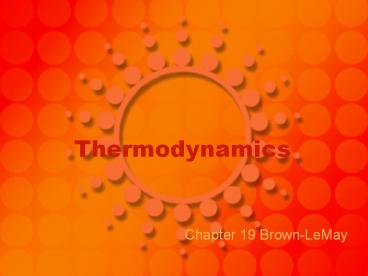Thermodynamics - PowerPoint PPT Presentation
Title:
Thermodynamics
Description:
Thermodynamics Chapter 19 Brown-LeMay ... – PowerPoint PPT presentation
Number of Views:305
Avg rating:3.0/5.0
Title: Thermodynamics
1
Thermodynamics
- Chapter 19 Brown-LeMay
2
I. Review of Concepts
- Thermodynamics area dealing with energy and
relationships - First Law of Thermo law of conservation of
energy - U q w - the change in internal energy of a system
equals q w - Internal energy is a state function one that is
independent of the pathway (altitude- state
function, miles traveled is not a state function
3
Concept review
- Heat (q) is the energy that moves into or out of
a system because of temperature differences
between the system and the surroundings - Work (w) energy exchange that results when a
force (f) moves an object through a distance (d)
w f x d - Work done to the system is positive work done by
the system is negative
4
Concept review
- Work in a chemical system can de described by the
pressure and change in volume of a system - W -p v
- u qp w cons. pressure
- u qp p v
- H is the reaction q at constant pressure
- H qp
5
Delta H
- More precisely H is the quantity u pv
- H u pv
- H u pv
- H qp pv pv
- H qp
- All U,P,V are state functions so H is also a
state function - H n H0f(products) - n H0f
(reactants)
6
II. Entropy and the Second Law
- Spontaneous reactions are a physical or
chemical change that occurs by themselves - When delta H is neg exothermic the reaction
tend to be spontaneous - Spontaneous reactions are non-reversible
- When delta H is positive endothermic the
reaction may or may not be spontaneous
7
II. Entropy and the Second Law
- Endothermic reactions are/not spontaneous because
of the naturally tendency to ether move towards
or away from a random state - Entropy S or S- is a measure of randomness or
disorder of a system (J/K) - state function (influenced by temp and
pressure)
8
The Second Law
- The entropy of a system and its surrounds always
increases in a spontaneous process - s s (final) s (initial)
- s increase in disorder
- s- decrease in disorder
- different from energy because it can be created
9
Second Law
- Delta S entropy created q/T
- Delta S gt q/T spontaneous
- Delta S q/T equilibrium
- For a process to be spontaneous at a given
temperature, the change in entropy of the system
is greater than the heat of they system divided
by the absolute temperature
10
Second Law (spontaneous rxn)
- Delta s gt qp/T Delta H/T
- Delta H/T Delta S lt 0
- H T S lt0 spontaneous
- H T S gt0 non-spontaneous
- H T S 0 Equilibrium
- You can often look up Delta H and Delta S
values form tables and determine if a reaction is
spontaneous as written under certain conditions
11
The Third Law Predicting Entropy Change
- Third Law a substance that is perfectly
crystalline at 0 Kelvin has an entropy of zero
as the temp of a substance is raised disorder
increases as it absorbs heat
12
Changes in Entropy
- In general Entropy increases as
- Liquids or solutions are formed from solids
- Gases are formed from either solids or liquids
- The number of molecules of gas increases
during a chemical reaction - the temperature of a substance in increased.
13
- Ludwig Boltzmann developed a method to
calculate entropies of substances based on the
number of possible arrangements of the particles
of a system - Standard Entropy So the entropy value for the
standard state of the species (indicated by the
subscript sign) - Gas pure sub at 1 atm tempt 250C or 298 k
Solutions are one molar. - Calc So Sum n So products - Sum n So reactants
14
Free Energy and Spontaneity
- The Gibbs free energy of a substance combines its
enthalpy and entropy into a single quantity that
describes the total amount of energy available
for use. - G H TS
- At const temp G H T S
- If G is neg(-) the rxn is spontaneous
- If G is pos() the rxn non-spontaneous
- If G is zero the rxn is at equilibrium
15
(No Transcript)














![L 18 Thermodynamics [3] PowerPoint PPT Presentation](https://s3.amazonaws.com/images.powershow.com/6877662.th0.jpg?_=20150709116)
















